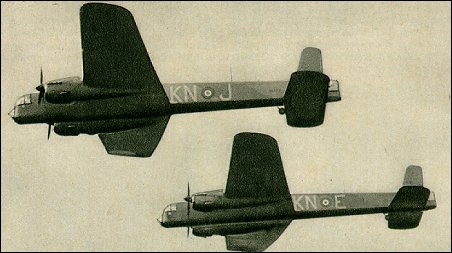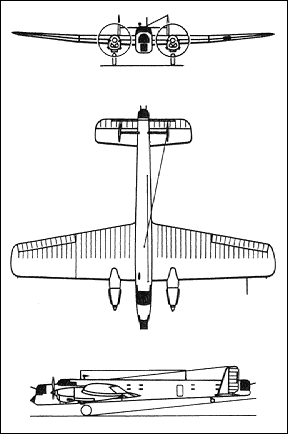|
| Most extensively built of all Armstrong Whitworth aircraft was the Whitley heavy bomber, designed to meet the British Air Ministry specification B.3/34. More than 1,800 were produced. Selected for production off the drawing board in 1935 the prototype flew for the first time on 17 March 1936. The second prototype and 34 Mk I production aircraft which followed were all powered by two 592.5kW Armstrong Siddeley Tiger IX radial engines. Mk IV, V and VII Whitleys, which followed later, had Rolls-Royce Merlin engines - these conferring considerably improved performance.
Whitleys began to enter RAF service in the early months of 1937 and by the outbreak of war in 1939 were wellestablished in the bomber squadrons. Being slower than the contemporary Handley Page Hampden and Vickers Wellington they were classed as night bombers. They were a vital component of Bomber Command operations until their withdrawal from front-line service in 1941. Achieving some of the major milestones of the war, the Whitley was responsible for the first widespread leaflet raids over Germany, in September 1939; the first bombing raid on Germany, in May 1940; the first bombing raid on Italy, in June 1940; and the first paratroop operation over Southern Italy, in February 1941. After its withdrawal from front-line service with Bomber Command the Whitley was converted for use as a general reconnaissance bomber and put into service by Coastal Command. In another converted form it was used to train the first British airborne troops and to take them into action for the first time, in a flight from England to Southern Italy. At the end of the war the type was still in service for training and other miscellaneous duties.

| CREW | 4-6 |
| ENGINE | 2 x RR "Merlin X", 840kW |
| WEIGHTS |
| Take-off weight | 12800 kg | 28219 lb |
| Empty weight | 8770 kg | 19335 lb |
| DIMENSIONS |
| Wingspan | 25.6 m | 84 ft 0 in |
| Length | 21.5 m | 71 ft 6 in |
| Height | 4.6 m | 15 ft 1 in |
| Wing area | 114.4 m2 | 1231.39 sq ft |
| PERFORMANCE |
| Max. speed | 357 km/h | 222 mph |
| Cruise speed | 297 km/h | 185 mph |
| Ceiling | 5360 m | 17600 ft |
| Range w/max.fuel | 2600 km | 1616 miles |
| Range w/max payload | 760 km | 472 miles |
| ARMAMENT | 5 machine-guns, 3150kg of bombs |
| Leo Rudnicki, 11.11.2009 19:38 Parachutists didn't jump out of the wings. A drooping fuselage is not aerodynamically optimum. No one copied A-W's solution to the problem, nor did anyone copy the Stirling. reply | | Al Mellor, e-mail, 11.11.2009 14:53 The Whitley flew nose down because the angle of incidence of the wing aws incresed so that the wing was at /near the point of the stall in the three point attitude. The other solution to this problem was adopted by Shorts for the Stirling - lengthen the undercarriage legs.
The nose down attitude would have increased with speed and wouldn't have been all that pronounced at the parachuting drop speed of 90 knots. Anyway there wouldn't have been a vacume affecting the bombs or parachutists as the pressure under the wing has to be higher than above it to produce lift. reply | | Ed Cooke, e-mail, 16.10.2009 00:20 A great old lady,did 20 trips with 102 Squadron before converting to Halifax 11,Can't understand a cruising speed of 185mph as quoted.Lucky to get 120 mph cruising speed,maybe they meant straight down at full throttle. reply | | Graham duHeaume, e-mail, 29.07.2009 18:26 How can I find the fate of a particular Whitley Mark 11
I work at the Shoreham airport archive centre. We have a lady who flew in one in 1941. She would like to know what happend to it. Reference K7227 . Belly landed at Pershore on 9 /5 /1940, it came to Gatwick for repair, which is where this lady worked. She flew in it to Shoreham, but from then on we have no more information. Can I find any more info. Thanks Graham reply | |
| | leo rudnicki, e-mail, 24.04.2009 02:54 I know why the Whitley flew nose down, but why was it designed to do so? I'm sure it benefitted parachutist dropping down the chute into a vacuum rather than slipstream but was it to suck the bombs out /of the bombbay? I have a hound that runs like a whitley, nose down,but I think that's a scent thing. reply | | EMBER, e-mail, 23.12.2007 00:14 YOUR RIGHT. IT WAS VERY EASY TO FLY, AND WAS VERY COMFORTABLE. THERE WAS ONLY TWO OR THREE FLAWS THAT PILOTS COMPLAINED ABOUT. reply | | John L. Hyde-Smith, e-mail, 16.10.2007 12:00 "Mediocre performance", "the plodding Whitley"; such comments abound regarding this bomber, yet was it really that bad? The fact is, the British aircraft industry could come up with nothing better in the years which led up to the Second World War, and the R.A.F. was well served by the Whitley until mid 1942 as a bomber, and until the end of the war as a maritime reconnaissance aircraft, a troop carrier and a trainer. It was reported as being easy and pleasant to fly, very important characteristics in an aircraft to be flown at night for long distances, and by the standards of its time it carried a heavy load. It was sturdy and could withstand much punishment. It is a horrible thought that R.A.F. bomber crews came uncomfortably close to having to go to war with some real plodders such as the Fairey Hendon and the Handley Page Heyford, and the results if that had happened just do not bear thinking about. I am sure that all concerned were very thankful for the Whitley and it is time that people stopped damning it with faint praise. reply |
|
Do you have any comments?
|
| 
COMPANY
PROFILE
All the World's Rotorcraft
|








